Kerby Anderson examines the characteristics of the millennial generation and how pastors, Christian leaders, and the church can reach out to this emerging generation.
Millennial Generation and Faith
Awhile back USA Today had a front page article on the millennial generation and faith.{1} It demonstrates that even mainstream newspapers are noticing a disturbing trend that many of us in the Christian world have been talking about for some time.
The article started out by saying, “Most young adults today don’t pray, don’t worship and don’t read the Bible.” Those are conclusions that come not only from USA Today but from research done by the Barna Research Group, the Pew Forum on Religion & Public Life, and LifeWay Christian Resources. Although the numbers differ slightly between groups, they all come to essentially the same conclusion. This emerging generation is less religious and less committed to the Christian faith than any generation preceding it.
The LifeWay study concluded that two-thirds (65%) rarely or never pray with others. Two thirds (65%) rarely or never attend worship services. And two-thirds (67%) don’t read the Bible or other sacred texts. As you might imagine, their theology is not orthodox. For example, when asked if Jesus is the only path to heaven, half say yes and half say no. Not surprisingly, only 17% say they read the Bible daily.
How important is faith or spirituality to the millennial generation? Apparently, it isn’t very important. When asked what was “really important in life,” two thirds (68%) did not mention faith, religion, or spirituality. And that term “spirituality” is an important one to remember. Almost three-fourths (72%) agree that they’re more spiritual than religious. This reflects their world. Lots of books, movies, and Web sites now promote spirituality that is anything but Christian.
Among the two thirds (65%) who call themselves Christians, “many are either mushy Christians or Christians in name only.” That is the conclusion of Thom Rainer, president of LifeWay Christian Resources. “Most are just indifferent. The more precisely you try to measure their Christianity, the fewer you find committed to the faith.”
This also shows up in behavior and personal morality. This generation is twice as likely as the baby boom generation to have had multiple sex partners by age eighteen.{2} Substance abuse and cheating are common. There is a tendency toward “short-horizon thinking” with a “live today, for tomorrow we die” ethic. After all, they live in a pop culture with no absolutes that is awash in moral relativism.
Thom Rainer believes the church needs to take responsibility. He says, “We have dumbed down what it means to be part of the church so much that it means almost nothing, even to people who already say they are part of the church.”
It is time for Christian leaders and pastors to get serious about what is happening to this generation. They need to take note and develop creative ways to reach out to a generation that has not connected with church and basic Christian doctrine.
Psychological Characteristics
A special report on the millennial generation describes several aspects of what many are calling the emerging generation in addition to faith.{3}
One characteristic is narcissism. Jean Twenge and Keith Campbell talk about the “narcissism epidemic” in their book to describe the soaring rates of self-obsession, attention-seeking, and an entitlement mindset among the youth.{4} They report that narcissistic personality traits have risen as fast as obesity from the 1980s to the present.
The emerging generation is also uninhibited. They are much more likely than previous generations to be open about the intimate details of their lives. They are casual about personal matters and lack understanding of appropriate boundaries and propriety. They also show disrespect for privacy. They will often post details online in an exhibitionist manner not found in previous generations. We will talk about this later when discussing their connectedness through social networks like Facebook and MySpace.
The emerging generation is overly self-confident. Millennials are rarely told no. They have also felt special and have inflated expectations of their own abilities and potential. Part of that optimism comes from the fact that they have rarely been allowed to fail. They have played in organized sports where everyone gets a trophy. They go to school where grade inflation is rampant.
The emerging generation is slow to make decisions. This generation is apt to explore all of the possibilities before making a commitment. This is understandable. If there is anything we have learned over the years in the social sciences, it is this: as choice increases, commitment decreases. The more choices I have, the less committed I will probably be to any one of those choices. In fact, I might even become more confused with those choices.
Some have argued that this difficulty in making decisions does two things. First, it causes members of this generation to doubt their own judgments. They live in the world of uncertainty. Second, it forces them to rely on authority figures to tell them what to do.{5}
These characteristics of the emerging generation pose a challenge to the church but one that can be met by those who disciple and mentor them. Biblical teaching and interaction with members of this generation about their self-image and self-esteem is a key component. We should also be willing to address the complexity of the world with thoughtful biblical answers.
Social Characteristics
The emerging generation would like to change the world. Six out of ten (60%) say they feel personally responsible for making a difference in the world.{6} This is encouraging since there are other surveys that also show this generation to be isolated and self-focused. The church and Christian leaders may be able to focus on this desire to change the world in calling for them to become leaders and make a difference in their communities.
This generation is also driven by pragmatism. They want what works. The positive aspect of this is that they are focused on results and getting something done. But the negative part of this is that pragmatism easily can lead to an “end justifies the means” mentality that can rationalize immoral and unethical actions.
The emerging generation also lives in a world of complexity. David Kinnaman and Gabe Lyons talk about this in their book, unChristian: What a New Generation Really Thinks about Christianity.{7} They say those in this generation “relish mystery, uncertainty, ambiguity. They are not bothered by contradictions.” When faced with a paradox or questions, they don’t feel the need to rush to find answers.
Bill Perry, founder of the Recon generational college ministry, explains: “The established generation is more interested in the bottom line (truth, biblical worldview, right answers, etc.) and in getting there as quickly as possible. Not so with the emerging generation. For them, it’s as much the journey as the destination.”
A fourth characteristic of this generation is most disturbing. They have a negative view of the church. David Kinnaman and Gabe Lyons describe this in some detail in their book unChristian. This generation sees themselves as “outsiders.” They view the church as anti-homosexual, judgmental, political, and hypocritical. They see born-again Christians in a negative light.
We should not be surprised. Imagine if you grew up in a world where your perceptions of Christianity were informed by The Simpsons, Comedy Central, and Saturday Night Live. Imagine if whenever you went to the movies, any character who was a Christian was always portrayed in a negative light. New stories talk about scandals in government, scandals in business, and scandals in the church. It would be very hard to not be cynical about major institutions in society, including the church.
This is certainly a call for us to live a righteous and authentic life. If we do so, I believe we can have a positive impact on this emerging generation.
Social Connections
The emerging generation is extremely well connected. This is easily illustrated by their use of networking sites like Facebook and MySpace. They also value teamwork, even to the point of showing groupthink. They have lots of connections, but one wonders how many of these connections would actually be what most of us would consider to be “friends.” Yes, they are called friends on these networking sites, but they may actually be fairly superficial.
This leads to another characteristic of this generation. Most in this generation are lonely. Sean McDowell, in his book Apologetics for a New Generation, calls them the “loneliest generation” because their relationships are mostly on the surface and don’t meet the deepest need of their heart.{8} Shane Hipps has a different term. He calls them “digital natives.” Those in the millennial generation are so accustomed to mediated interaction that they find face-to-face interaction increasingly intolerable and undesirable. This is especially true when discussing a conflict.{9}
The emerging generation multitasks. They are the consummate multitaskers. Nearly one-third of 8- to 18-year olds say they multitask “most of the time” by doing homework, watching TV, sending text messages, surfing the Web, or listening to music. And they do all of this simultaneously.
First, this is dangerous. Researchers have found that talking or texting is much more dangerous than many of us might even imagine. The Center for Auto Safety has released hundreds of pages of research documenting the dangerous impact of cell phone use on America’s highways.{10} Talking or texting while driving is more dangerous than driving drunk.
Second, it is also relationally damaging. This generation thinks nothing of texting others while in the presence of other people. As we have just mentioned, they would rather send a text or e-mail than talk to a person face-to-face.
The emerging generation is overwhelmingly stressed out. One fourth of millennials feel unfulfilled in life, and nearly half say they are stressed out. This is twice the level of baby boomers. What is even more disturbing is that most parents are unaware of how stressed out their children are and how that is negatively impacting them. One very tragic result of this stress is the suicide rate. Suicide is the third leading cause of death among 15- to 24-year-olds.
Biblical Perspective
We noted that this is a generation that is narcissistic (2 Timothy 3:1-2) and overly self-confident. This is where the Bible and the church can provide perspective to a generation with great expectations and unwarranted confidence. Messages and Sunday school lessons along with discipleship programs aimed at issues like ego (Philippians 2:1-10), pride (Proverbs 16:18-19), and envy (Galatians 5:21) would be important to address some of these characteristics of the emerging generation.
This is a generation that finds it difficult to make decisions. Here is an opportunity to come alongside members of the emerging generation and provide them with biblical tools (2 Timothy 2:15) for wise and moral decision-making. Messages (sermons, lessons) on the importance of commitment and how following biblical principles concerning life decisions can develop confidence and responsibility would also be important.
Many in the emerging generation want to change the world. This is an opportunity for pastors, teachers, and mentors to challenge this generation to make an impact for Jesus Christ in our world. We should challenge them with the Great Commission (Matthew 28:19-20).
The emerging generation has a negative view of the church. When the institutional church has been wrong, we should be willingly to admit it. But we should also be alert to the fact that sometimes the criticisms we hear are unjustified. Skeptics might know someone who professes to be a Christian who they believe is a hypocrite. The person may not really be a Bible-believing Christian. Or he may not be representative of others in the same church.
We should also be willing to challenge the stereotype skeptics have of Christianity. If all they know of Christianity is what they see on television or read in the newspapers, they may not have an accurate view of Christianity.
This generation is also lonely and stressed out. They need to know how to develop deep, lasting relationships (Proverbs 18:24). They live in a world where relationships are disposable. It is a world where a “friend” on Facebook can “delete” them by hitting a key on their computer keyboard. They also need to learn how to develop friendships without becoming codependent.
They also need to know that a relationship with Christ provides a peace “which surpasses all comprehension” (Philippians 4:7). They may also need instruction on practical life issues and learn to develop healthy habits that develop their physical, emotional, and spiritual dimensions.
Pastors, church leaders, and individual Christians have an opportunity to make a positive impact on this emerging generation. Hopefully this has given you a better understanding of this generation and provided practical ideas for ministry.
Notes
1. Cathy Lynn Grossman, “Young adults less devoted to faith,” USA Today, 27 April 2010, 1A.
2. www.kff.org/youthhivstds/upload/U-S-Teen-Sexual-Activity-Fact-Sheet.pdf.
3. Jeff Myers and Paige Gutacker, A Special Report: Unraveling the Mysteries of the Millennial Generation, www.passingthebaton.org.
4. Jean M. Twenge and W. Keith Campbell, The Narcissism Epidemic: Living in the Age of Entitlement (NY: Free Press, 2009).
5. Ron Alsop, The Trophy Kids Grow Up: How the Millennial Generation is Shaking Up the Workplace (San Franciso, CA: Josey-Bass, 2008), pp. 12, 115.
6. Survey by Cone Inc., a communications agency, and Amp Insights, a marketing agency, 2006.
7. David Kinnaman and Gabe Lyons talk about this in their book, unChristian: What a New Generation Really Thinks about Christianity (Grand Rapids, MI: Baker Books, 2007).
8. Sean McDowell, Apologetics for a New Generation (Eugene, OR: Harvest House Publishing, 2009).
9. Shane Hipps, Lecture entitled “The Spirituality of the Cell Phone,” Q conference, Austin, TX, 28 April 2009.
10. Center for Auto Safety, www.autosafety.org.
© 2010 Probe Ministries


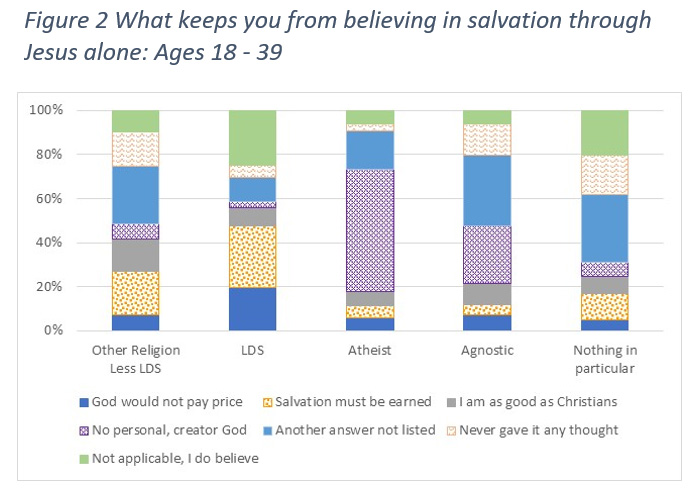 To get a better understanding of what drives these results, we dove further into the makeup of each of these two groups. The results are shown in Figure 2.
To get a better understanding of what drives these results, we dove further into the makeup of each of these two groups. The results are shown in Figure 2.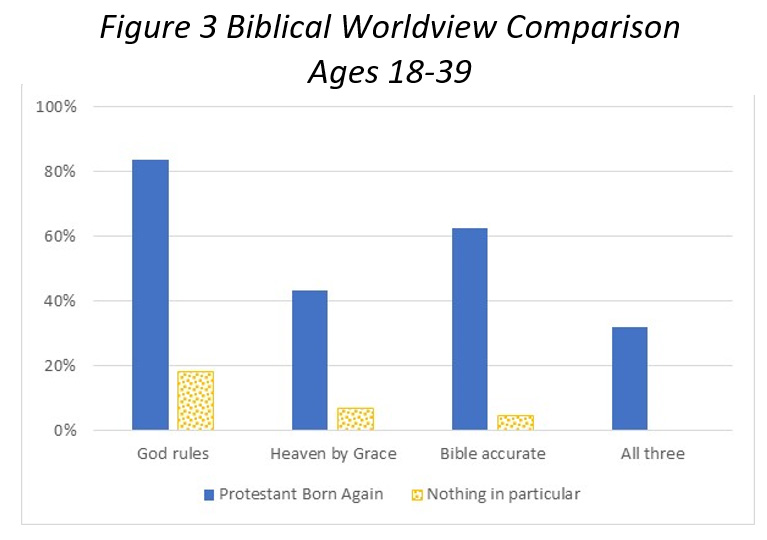 Let’s compare the results for Born-again Protestants and those who claimed to be Nothing in Particular. As shown in Figure 3, for each of the questions those agreeing with a biblical worldview among the Nothing in Particulars is a small fraction of those among Born-again Protestants. When we combine the three questions together, we see one out of three Born-again Protestants vs. no NIPs. Certainly, some of these NIPs came from an evangelical background, but none of them interviewed in our survey ascribe to a basic evangelical worldview as adults. As noted in our first report, one in three orn-again Protestants is a disappointing percentage ascribing to these biblical worldview questions, but it is certainly dramatically better than the Nothing in Particular group.
Let’s compare the results for Born-again Protestants and those who claimed to be Nothing in Particular. As shown in Figure 3, for each of the questions those agreeing with a biblical worldview among the Nothing in Particulars is a small fraction of those among Born-again Protestants. When we combine the three questions together, we see one out of three Born-again Protestants vs. no NIPs. Certainly, some of these NIPs came from an evangelical background, but none of them interviewed in our survey ascribe to a basic evangelical worldview as adults. As noted in our first report, one in three orn-again Protestants is a disappointing percentage ascribing to these biblical worldview questions, but it is certainly dramatically better than the Nothing in Particular group.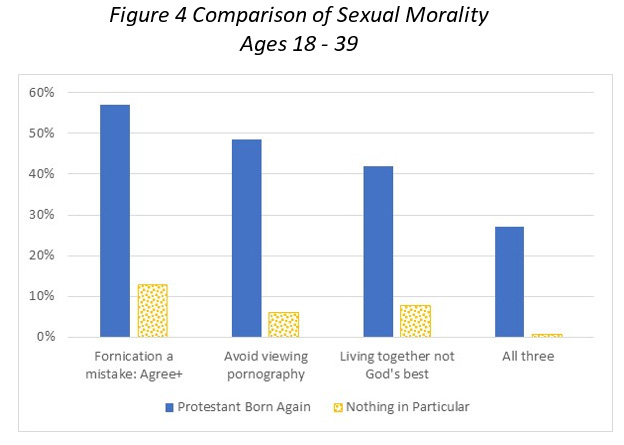 The results from our survey are shown in Figure 4. Once again, we see a large difference between these two groups. Clearly, the NIPs do not ascribe to a biblical view on sexual morality. The majority of Born-again Protestants do not ascribe to those beliefs either, but a significant minority of them do.
The results from our survey are shown in Figure 4. Once again, we see a large difference between these two groups. Clearly, the NIPs do not ascribe to a biblical view on sexual morality. The majority of Born-again Protestants do not ascribe to those beliefs either, but a significant minority of them do. Results from the first question are plotted in Figure 1. As shown, here and in the next three graphs, we will look at those ages 18 through 29 next to those ages 40 through 55 to see if there are differences based on age. If there is a trend or variation seen in the 30 through 39 age group, then that one is also shown as seen for Born Again Protestants in Figure 1.
Results from the first question are plotted in Figure 1. As shown, here and in the next three graphs, we will look at those ages 18 through 29 next to those ages 40 through 55 to see if there are differences based on age. If there is a trend or variation seen in the 30 through 39 age group, then that one is also shown as seen for Born Again Protestants in Figure 1. Pornography.
Pornography. The third question examines views on whether it is a good thing to live together in a sexual relationship before committing to marriage. The results are summarized in Figure 3. This is another question where Born Again Protestants show a significant difference based on age. The older group, 40 through 55, shows almost 60% who say that it should be avoided as instructed by God. The younger group, 18 through 29, shows only 40% with the same viewpoint. Across all age ranges only about one half of Born Again Protestants say that this practice should be avoided. So, even among this group, over half believe that it is okay and might be helpful.
The third question examines views on whether it is a good thing to live together in a sexual relationship before committing to marriage. The results are summarized in Figure 3. This is another question where Born Again Protestants show a significant difference based on age. The older group, 40 through 55, shows almost 60% who say that it should be avoided as instructed by God. The younger group, 18 through 29, shows only 40% with the same viewpoint. Across all age ranges only about one half of Born Again Protestants say that this practice should be avoided. So, even among this group, over half believe that it is okay and might be helpful. The verse above tells us two things. First, that someone who is given over to homosexual activity (like those given over to idolatry, sexual immorality, and greed) are not true followers of Christ. Even in Paul’s era, many were apparently saying they would inherit the kingdom of God and so Paul begins the statement by saying “Do not be deceived.” But it also clearly states that such a one can be washed, sanctified and justified in Jesus Christ. As Christians, we should love them and tell them the truth that God has a better way for their life.
The verse above tells us two things. First, that someone who is given over to homosexual activity (like those given over to idolatry, sexual immorality, and greed) are not true followers of Christ. Even in Paul’s era, many were apparently saying they would inherit the kingdom of God and so Paul begins the statement by saying “Do not be deceived.” But it also clearly states that such a one can be washed, sanctified and justified in Jesus Christ. As Christians, we should love them and tell them the truth that God has a better way for their life. Clearly, ones in the older group are more likely to take a biblical view on sexual behavior. In fact, on the far right, we see that those 40 to 55 are twice as likely as those 18 to 29 to hold to a biblical view. However, more important, is that over 80% of the younger ages and over 75% of the oldest ages do not hold to a biblical view on these combined topics regarding sexual behavior.
Clearly, ones in the older group are more likely to take a biblical view on sexual behavior. In fact, on the far right, we see that those 40 to 55 are twice as likely as those 18 to 29 to hold to a biblical view. However, more important, is that over 80% of the younger ages and over 75% of the oldest ages do not hold to a biblical view on these combined topics regarding sexual behavior. The first two answers are consistent with a Basic/Enhanced Biblical Worldview, reflecting 1) a view that their scripture is informed by a higher source of truth than simple science can draw upon, 2) a recognition that generally accepted scientific viewpoints have often changed over time, and 3) on the type of scientific questions being addressed here, there are in most cases a variety of theories supported by different groups of scientists. The second answer includes the possibility that the person’s holy scriptures do not directly address the topic at hand, but that some religious leaders have inferred a position on the topic from their interpretation of scriptures.
The first two answers are consistent with a Basic/Enhanced Biblical Worldview, reflecting 1) a view that their scripture is informed by a higher source of truth than simple science can draw upon, 2) a recognition that generally accepted scientific viewpoints have often changed over time, and 3) on the type of scientific questions being addressed here, there are in most cases a variety of theories supported by different groups of scientists. The second answer includes the possibility that the person’s holy scriptures do not directly address the topic at hand, but that some religious leaders have inferred a position on the topic from their interpretation of scriptures. Note these answers follow a similar pattern to those of the first question, but now they are applied to a specific question where many people assume there is no meeting ground between science and religion.
Note these answers follow a similar pattern to those of the first question, but now they are applied to a specific question where many people assume there is no meeting ground between science and religion. First note that if we strictly define real scientists as individuals meeting these qualifications—1) a Ph.D. in a scientific field, 2) actively involved in the field, and 3) published in reputable scientific journals—we will find many scientists who agree that there are other sources of truth outside of science. So, we can say with confidence that the statement in question #3 is objectively, verifiably not true. However, there are certainly some believers in scientism [the belief that science is the only way to know ultimate truth] who claim the statement is true. They accomplish this trick by claiming that anyone who does not believe that science is the only source of real truth cannot by definition be a real scientist.
First note that if we strictly define real scientists as individuals meeting these qualifications—1) a Ph.D. in a scientific field, 2) actively involved in the field, and 3) published in reputable scientific journals—we will find many scientists who agree that there are other sources of truth outside of science. So, we can say with confidence that the statement in question #3 is objectively, verifiably not true. However, there are certainly some believers in scientism [the belief that science is the only way to know ultimate truth] who claim the statement is true. They accomplish this trick by claiming that anyone who does not believe that science is the only source of real truth cannot by definition be a real scientist. What do the results look like when we combine these questions? In our opinion, there are a number of different answers that could be consistent with a biblical worldview. Starting with the strictest view of relying on the Bible rather than science and then adding in those who would look at the results from science to obtain a clearer understanding of what the Bible teaches or those areas where the Bible is silent. Then, we add in their view on scientism which as already discussed is demonstrated by a long list of scientists who disagree to be false, thus being a source of strong disagreement.
What do the results look like when we combine these questions? In our opinion, there are a number of different answers that could be consistent with a biblical worldview. Starting with the strictest view of relying on the Bible rather than science and then adding in those who would look at the results from science to obtain a clearer understanding of what the Bible teaches or those areas where the Bible is silent. Then, we add in their view on scientism which as already discussed is demonstrated by a long list of scientists who disagree to be false, thus being a source of strong disagreement. A natural question to ask is, “Does having a Basic Biblical Worldview correlate with having a biblical view on these science issues?” We can look at this question by comparing Born Again Protestants with a Basic Biblical Worldview with Born Again Protestants without a Basic BWV. The results are shown in the adjacent figure.
A natural question to ask is, “Does having a Basic Biblical Worldview correlate with having a biblical view on these science issues?” We can look at this question by comparing Born Again Protestants with a Basic Biblical Worldview with Born Again Protestants without a Basic BWV. The results are shown in the adjacent figure.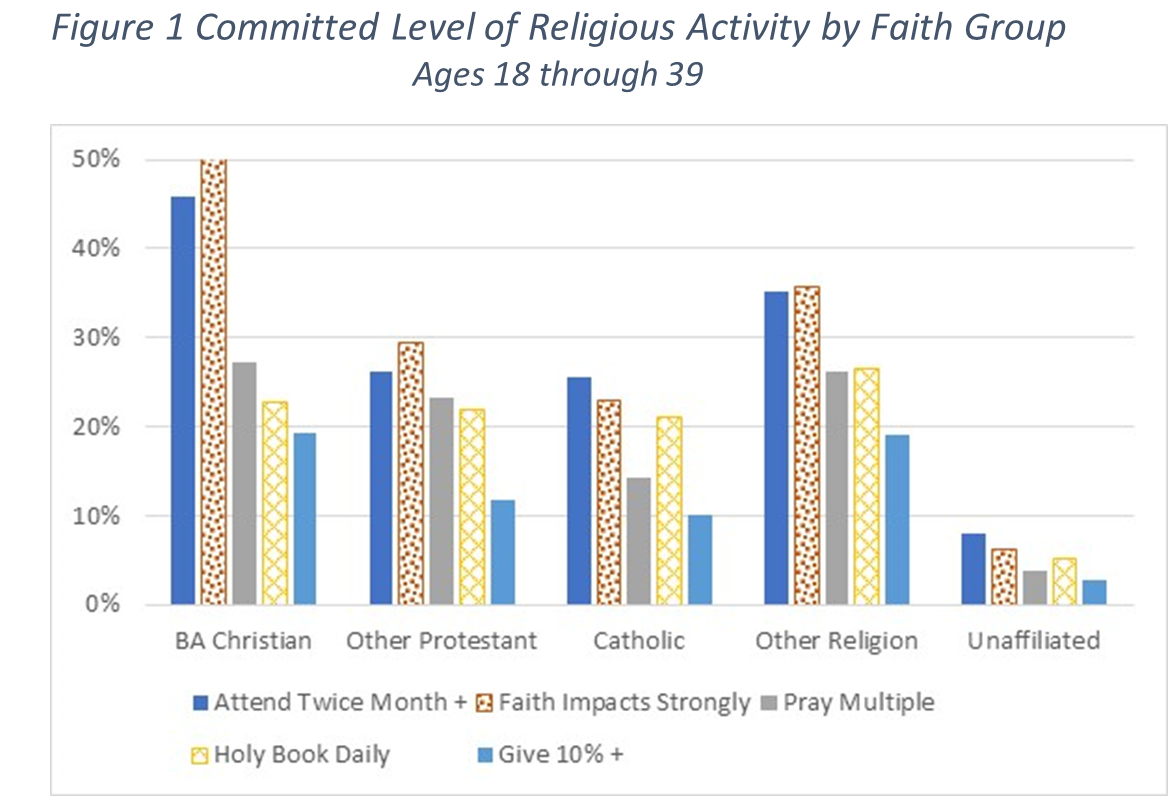
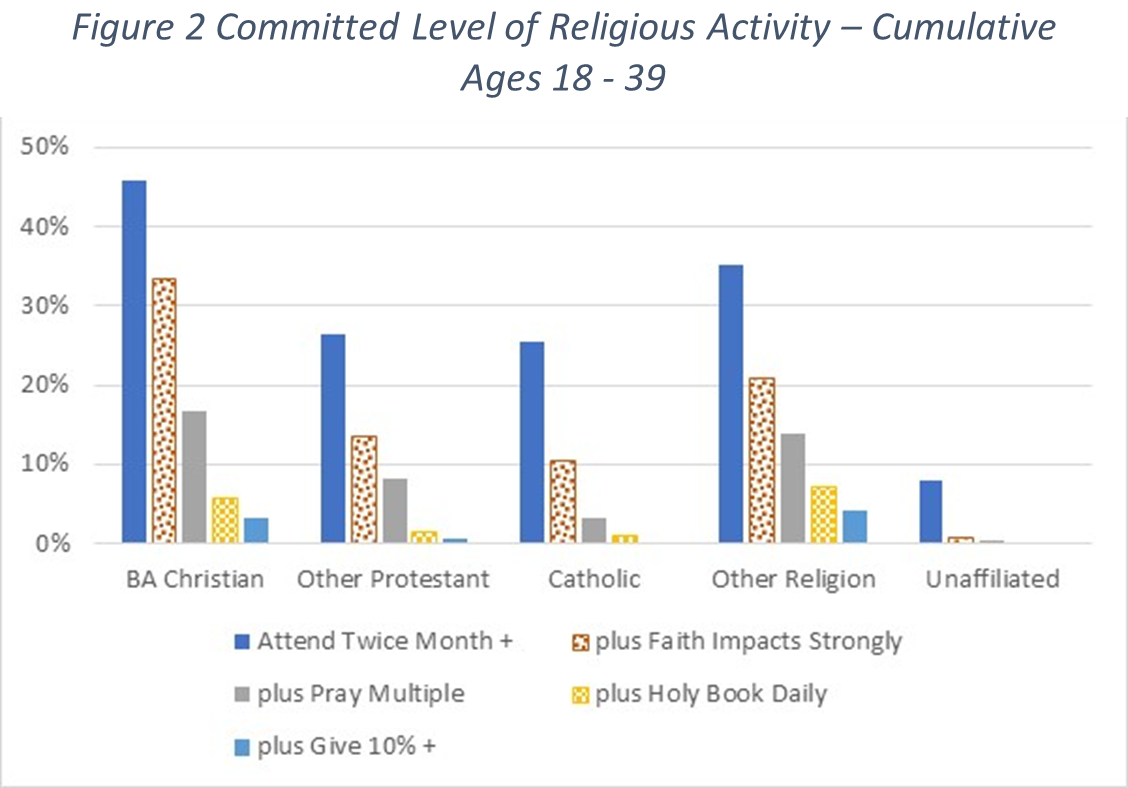
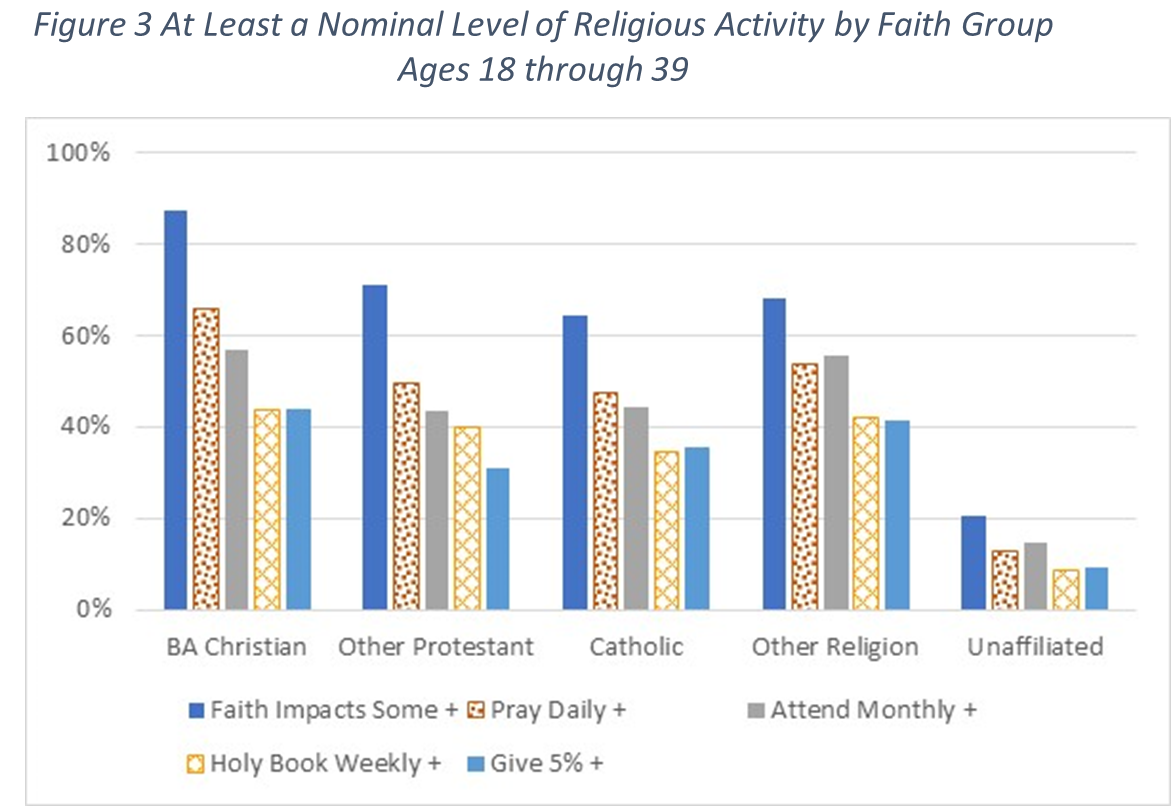 Nominal or Committed Levels of Religious Activity
Nominal or Committed Levels of Religious Activity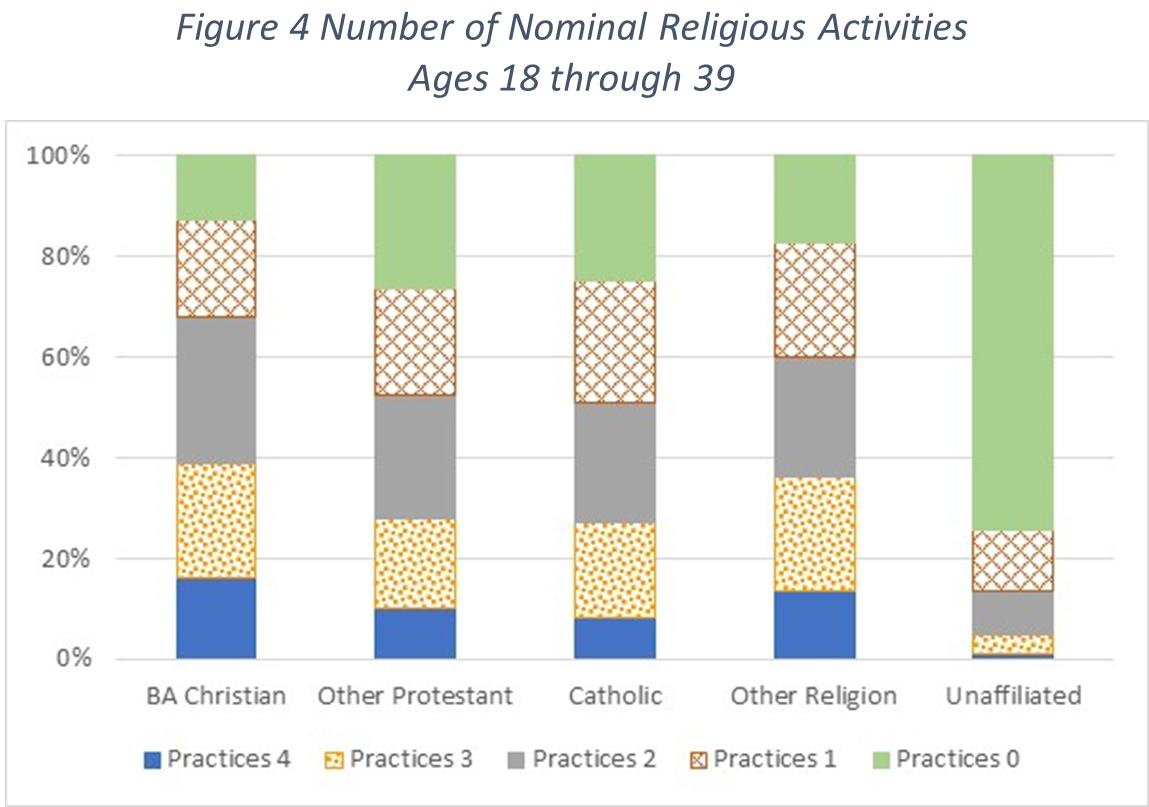
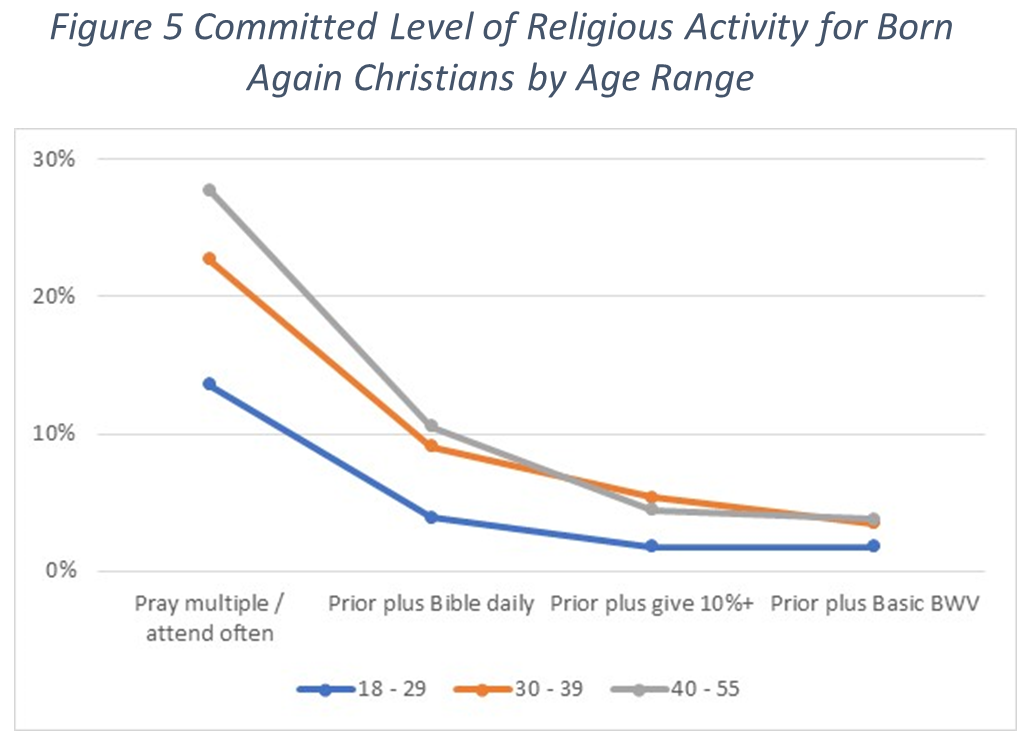
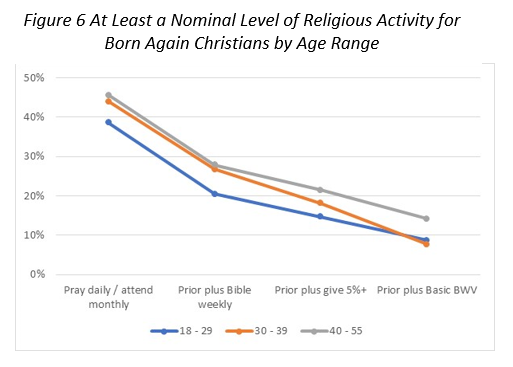
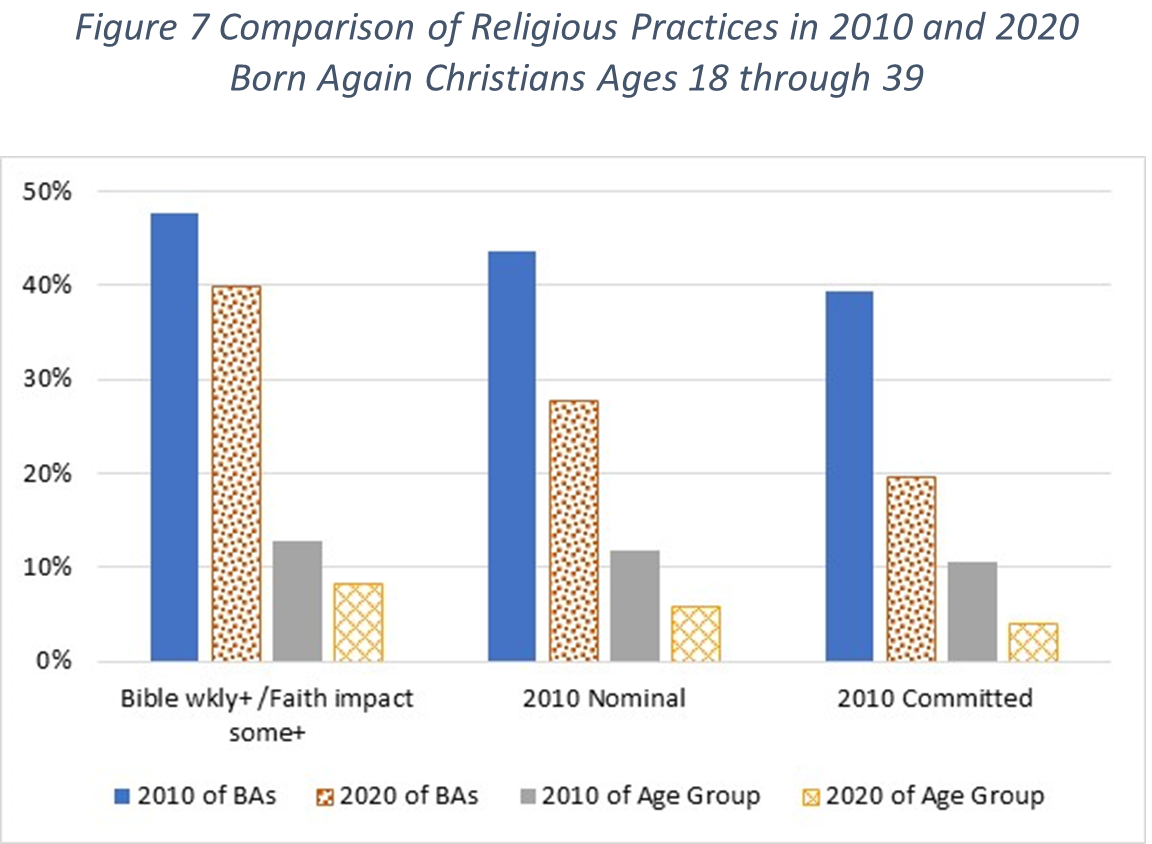
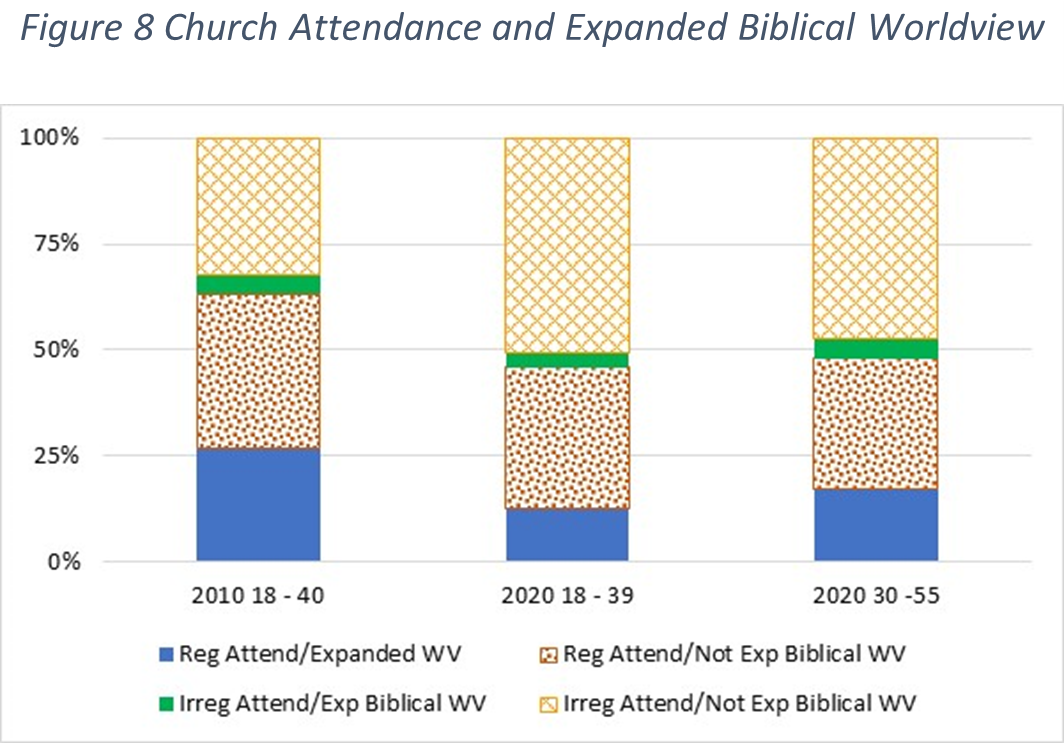 The figure on the left compares the findings from 2010 with those from 2020 using the more stringent Expanded Biblical Worldview. The values shown are the percent of Born-Again Christians (so all columns add up to 100% even though the percentage of Born Again Christians is less in 2020). Two age ranges are used in 2020; the first one is basically the same age range used in 2010 (18 – 39) and the second age range (30 – 55) is very close to the age range of the 2010 survey aged by the ten years that have gone by.
The figure on the left compares the findings from 2010 with those from 2020 using the more stringent Expanded Biblical Worldview. The values shown are the percent of Born-Again Christians (so all columns add up to 100% even though the percentage of Born Again Christians is less in 2020). Two age ranges are used in 2020; the first one is basically the same age range used in 2010 (18 – 39) and the second age range (30 – 55) is very close to the age range of the 2010 survey aged by the ten years that have gone by.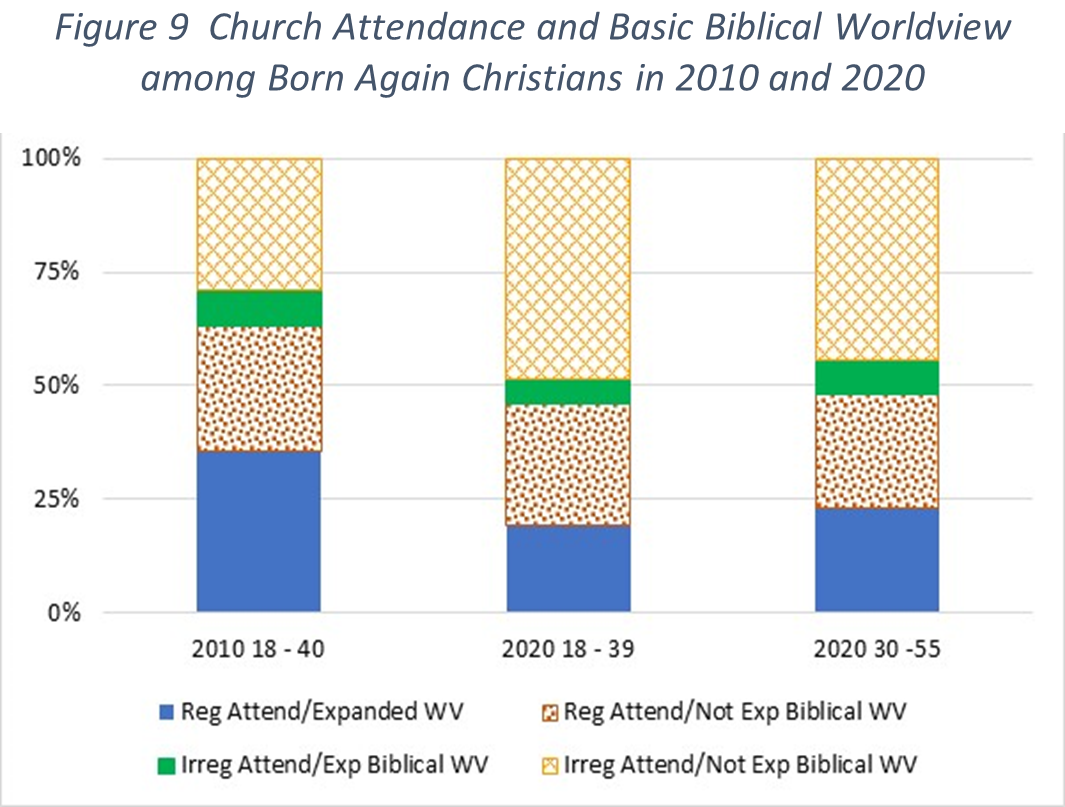 Now let’s examine the same chart using a Basic Biblical Worldview. We see nearly the same features as discussed above. A significant drop is shown in those with regular attendance and a Basic Biblical Worldview coupled with a significant increase in those with irregular attendance and no Basic Biblical Worldview.
Now let’s examine the same chart using a Basic Biblical Worldview. We see nearly the same features as discussed above. A significant drop is shown in those with regular attendance and a Basic Biblical Worldview coupled with a significant increase in those with irregular attendance and no Basic Biblical Worldview.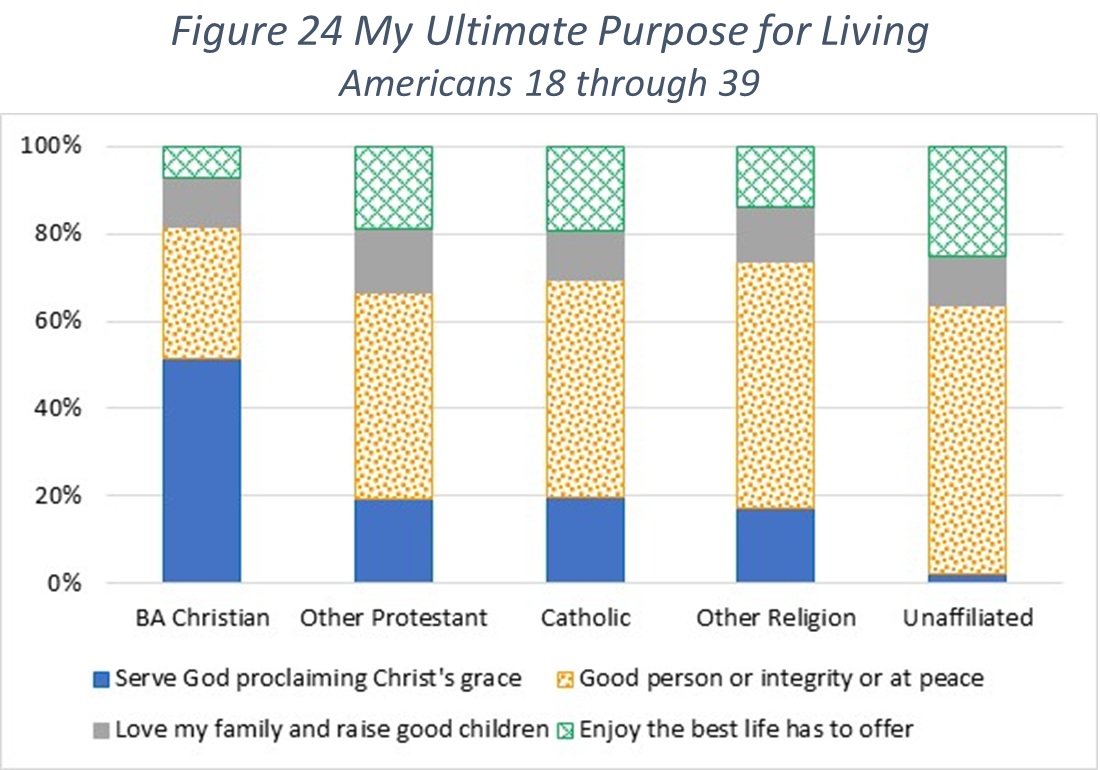 The results are charted in the graph to the left. As shown, just over half of Born Again Christians profess an eternal perspective. This means almost half do not, with most of those selecting a purpose that focuses on good behaviors in their personal life.
The results are charted in the graph to the left. As shown, just over half of Born Again Christians profess an eternal perspective. This means almost half do not, with most of those selecting a purpose that focuses on good behaviors in their personal life.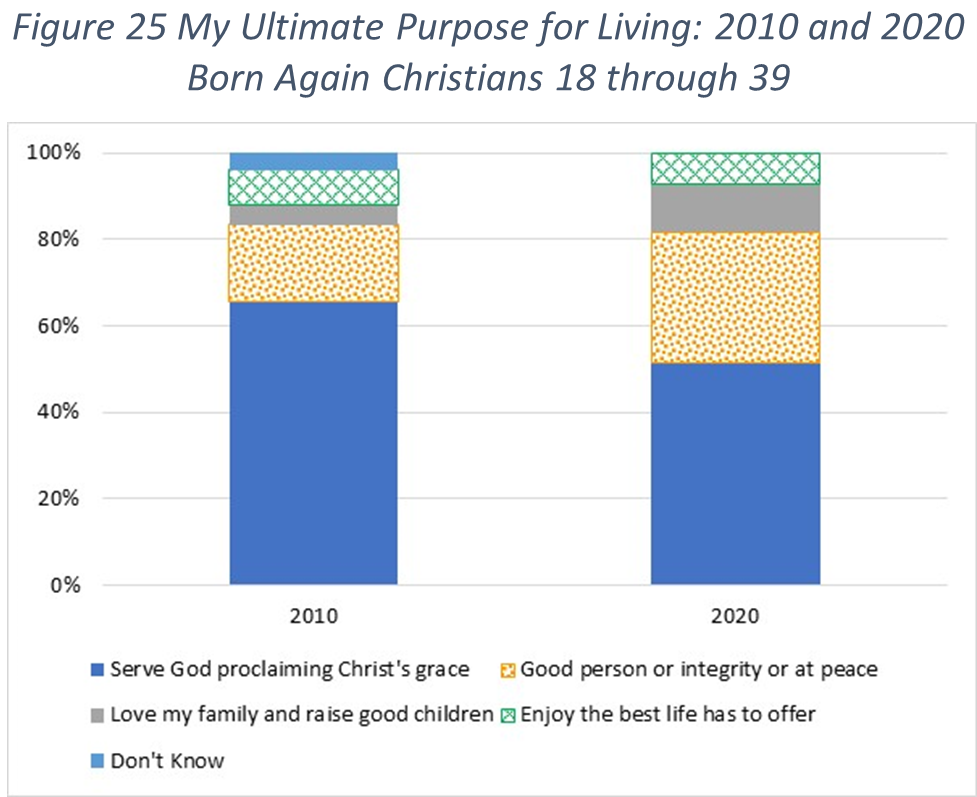
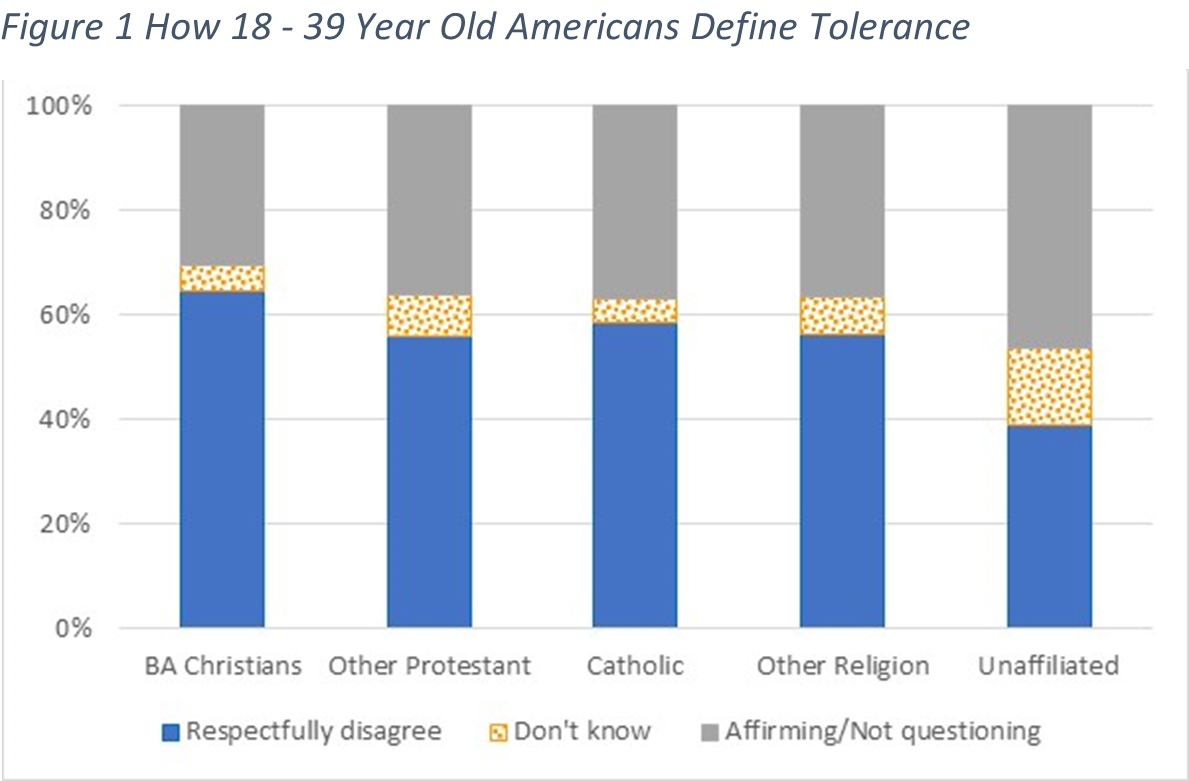
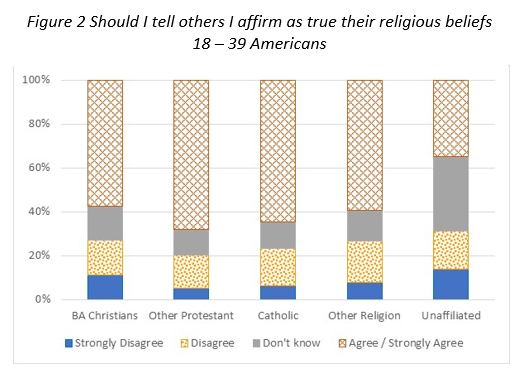
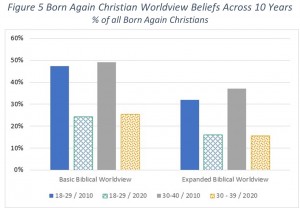 Now let’s compare these 2020 results with the results from our 2010 survey. Figure 5 shows the results across this decade for Born Again Christians looking at the percent who agree with the worldview answers above. As shown, there has been a dramatic drop in both the Basic Biblical Worldview and the Expanded Biblical Worldview.
Now let’s compare these 2020 results with the results from our 2010 survey. Figure 5 shows the results across this decade for Born Again Christians looking at the percent who agree with the worldview answers above. As shown, there has been a dramatic drop in both the Basic Biblical Worldview and the Expanded Biblical Worldview.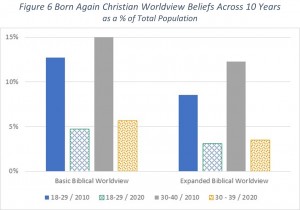 However, because the percent of the population who profess to being born again has dropped over the last ten years as well, the situation is even worse. We need to look at the percent of Americans of a particular age range who hold to a Biblical Worldview. Those results are shown in Figure 6. Once again, comparing the 18–29 age group from 2010 with the same age group ten years later now 30–39, we find an even greater drop off. For the Basic Biblical Worldview, we see a drop off from 13% of the population down to 6%. For the Expanded Biblical Worldview, the decline is from 9% down to just over 3% (a drop off of two thirds).
However, because the percent of the population who profess to being born again has dropped over the last ten years as well, the situation is even worse. We need to look at the percent of Americans of a particular age range who hold to a Biblical Worldview. Those results are shown in Figure 6. Once again, comparing the 18–29 age group from 2010 with the same age group ten years later now 30–39, we find an even greater drop off. For the Basic Biblical Worldview, we see a drop off from 13% of the population down to 6%. For the Expanded Biblical Worldview, the decline is from 9% down to just over 3% (a drop off of two thirds).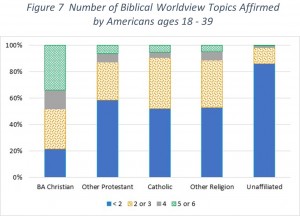 Rather than look at the two biblical worldview levels discussed above, we will look at how many of the six biblical worldview questions they answered were consistent with a biblical worldview. In the chart, we look at 18- to 39-year-old individuals grouped by religious affiliation and map what portion answered less than two of the questions biblically, two or three, four, or more than four (i.e., five or six).
Rather than look at the two biblical worldview levels discussed above, we will look at how many of the six biblical worldview questions they answered were consistent with a biblical worldview. In the chart, we look at 18- to 39-year-old individuals grouped by religious affiliation and map what portion answered less than two of the questions biblically, two or three, four, or more than four (i.e., five or six).